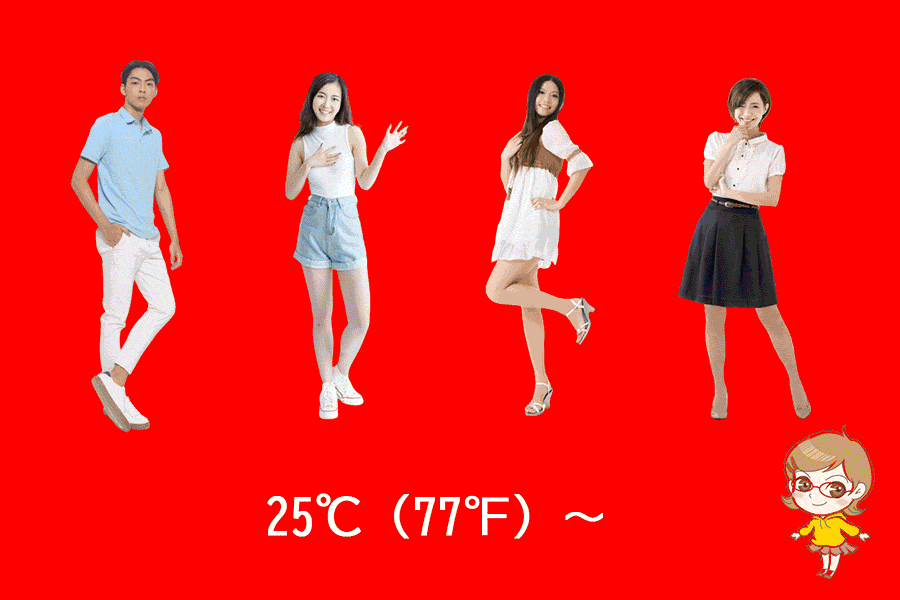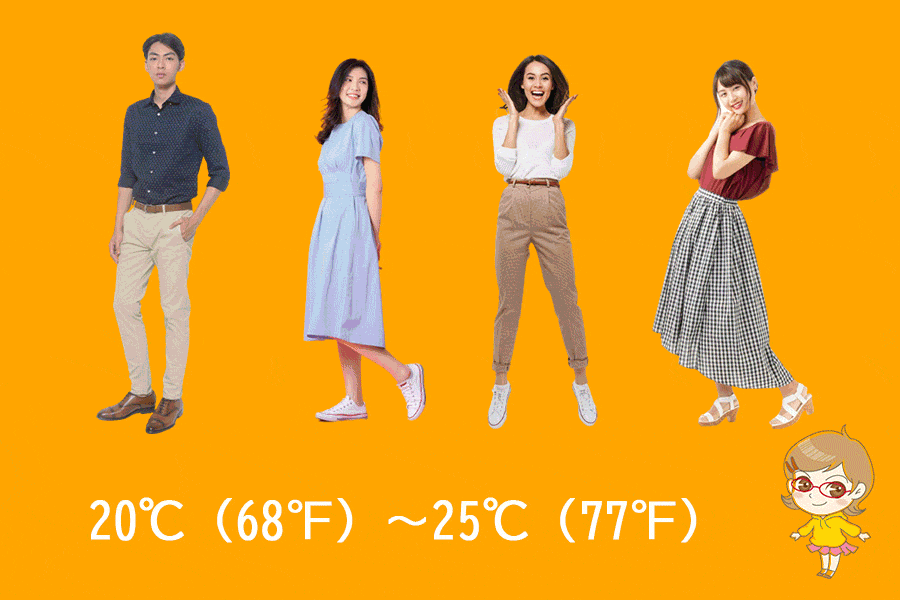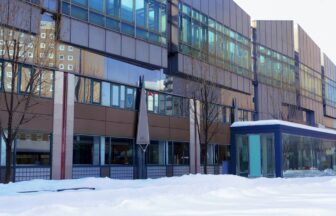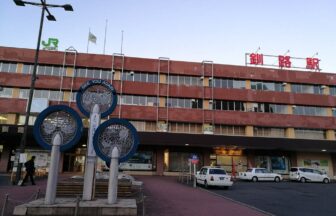3-chōme-1 Shinmachi, Abashiri, Hokkaido 093-0046 MAP
↓ Click to jump to the relevant section.
| Current Weather | Annual Weather | Tourist Attractions |
| Baggage Deposit | Hotels |
Current weather and clothing

The weather information shown here is the information closest to the station in question. Please note that there may be slight differences.
Yearly temperature changes and recommended clothing
Clothing recommendations for each temperature range
When traveling in Japan with the following average temperatures, the recommended clothing is as follows:
Monthly changes in temperature, precipitation, and snowfall (1991~2020 average, Japan Meteorological Agency survey)
| Jan. | Feb. | Mar. | Apr. | May | Jun. | Jul. | Aug. | Sep. | Oct. | Nov. | Dec. | |
| temperature(°C) | -5.1 | -5.4 | -1.3 | 4.5 | 9.8 | 13.5 | 17.6 | 19.6 | 16.8 | 10.9 | 4 | -2.4 |
| precipitation(mm) | 53.8 | 41.9 | 39.3 | 51.2 | 64.1 | 68.1 | 85.8 | 115.3 | 115 | 88.2 | 58.1 | 63.6 |
| snowfall(cm) | 90 | 69 | 52 | 15 | 1 | — | — | — | — | 0 | 13 | 71 |
Winter
November
November in Abashiri is cold, with an average temperature of 4°C. Snowfall is common in this month, so tourists should bring warm clothing and waterproof boots. It is also recommended to carry extra clothing in case of weather changes.
December
The average temperature in Abashiri in December is around -2.4°C, making it one of the coldest months of the year. The amount of precipitation is relatively low, with an average of around 71mm of snowfall expected throughout the month. It’s important to note that temperatures can drop below freezing and snow is a common occurrence during this time, so tourists visiting from overseas should be prepared for cold and potentially snowy conditions.
For women, it’s recommended to pack warm clothing such as a heavy coat, hat, gloves, and scarf. Layers are also important as they provide extra insulation against the cold, so consider wearing thermal underwear, a sweater, and a jacket. Waterproof and warm footwear, such as boots, are also a must, as snow and ice can make sidewalks and streets slippery. For men, it’s recommended to pack similar clothing items, including a heavy coat, hat, gloves, and scarf. Layers are also important for extra insulation against the cold, so thermal underwear, a sweater, and a jacket are also recommended. Waterproof and warm footwear, such as boots, should also be packed, as snow and ice can make sidewalks and streets slippery. In addition, consider bringing waterproof pants to protect against the snow and rain.
January
January in Abashiri is characterized by cold weather with an average temperature of -5.1°C. It is important to wear warm clothing such as a heavy coat, gloves, and a hat to protect against the low temperatures. Additionally, it is recommended to wear waterproof clothing and boots as there is a moderate amount of snowfall in this month. Tourists should also be prepared for strong winds and be cautious of icy roads.
February
February in Abashiri continues to have cold weather with an average temperature of -5.4°C. It is important to dress warmly, with heavy clothing and accessories to protect against the cold. Snowfall is also common in this month, so tourists should bring waterproof clothing and boots. It is also recommended to carry extra clothing in case of weather changes.
March
In March, the temperature in Abashiri begins to warm up slightly, with an average temperature of -1.3°C. However, snow is still common, so it is important to wear warm clothing and waterproof boots. Tourists should be prepared for unpredictable weather changes and bring clothing that can be layered. It is also recommended to carry an umbrella or raincoat as precipitation is still moderate in this month.
Spring
April
April in Abashiri sees further warming, with an average temperature of 4.5°C. However, tourists should still be prepared for cold and wet weather, especially as there is still some snowfall in this month. It is recommended to wear warm clothing that can be easily removed in case of sudden weather changes. A waterproof jacket and boots are also necessary as precipitation is moderate in this month.
May
May in Abashiri is relatively warm, with an average temperature of 9.8°C. Although snow is less common, tourists should still be prepared for occasional rain and bring a waterproof jacket and boots. Light clothing such as a light coat or sweater is recommended, as well as a hat or sunglasses to protect against the sun.
June
June in Abashiri is even warmer, with an average temperature of 13.5°C. Rain is still common in this month, so tourists should bring a waterproof jacket and boots. Light clothing such as a light coat or sweater is recommended, as well as a hat or sunglasses to protect against the sun.
Summer
July
Along with August, July is the warmest month in Abashiri, with an average temperature of about 17.6°C. There is also a moderate amount of precipitation, so tourists should bring a waterproof jacket and boots. Light clothing is recommended, as well as a hat or sunglasses to protect against the sun.
August
August in Abashiri continues to be warm, with an average temperature of 19.6°C. Precipitation is moderate in this month, so tourists should bring a waterproof jacket and boots. Light clothing is recommended, as well as a hat or sunglasses to protect against the sun.
Autumn
September
September in Abashiri is characterized by slightly cooler temperatures, with an average temperature of 16.8°C. Precipitation is also moderate in this month, so tourists should bring a waterproof jacket and boots. Light clothing is recommended, as well as a hat or sunglasses to protect against the sun.
October
October in Abashiri sees a drop in temperature, with an average temperature of 10.9°C. Precipitation is moderate in this month, so tourists should bring a waterproof jacket and boots. Warm clothing is recommended, as well as a hat or sunglasses to protect against the sun.
Recommended tourist destinations
Abashiri Prison Museum
1-1 Yobito, Abashiri 099-2421 Hokkaido
A historical museum that relocated and restored the Abashiri Prison built in 1896. As the oldest wooden prison in Japan, it is registered as a National Important Cultural Property.
Hokkaido Museum of Northern Peoples
309-1 Shiomi, Abashiri 093-0042 Hokkaido
This museum introduces the culture of the Ainu, Inuit, and other northern peoples. Actual materials related to food, clothing, shelter, and rituals are on display.
Okhotsk Ryu-hyo Museum
244-3 Tentozan, Abashiri 093-0044 Hokkaido
Actual drift ice is on permanent display. Visitors can experience the extreme cold of minus 18 degrees Celsius even in summer. Clione, the angel of drift ice, can also be seen.
Abashiri Sightseeing Icebreaker Aurora
4-5-1, East 4-chome, Minami 3-jo, Abashiri, 093-0003 Hokkaido
The large sightseeing boat will take you on an icebreaking tour over the white “drift ice” covering the Sea of Okhotsk.Sometimes, you may see wild animals such as seals and Steller’s sea eagles. The tour runs from January 20 to March 31.
Cape Notoro
Misaki, Abashiri 093-0087 Hokkaido
A 40-60 m cliff stretches out into the Sea of Okhotsk, and a lighthouse stands at the tip. From the cape with its grazing landscape, you can see drift ice in winter.
Michi-no-Eki Ryuhyokaido Abashiri
4 Higashi, Minami, Abashiri 093-0003 Hokkaido
It provides tourist information and sells processed local agricultural and marine products. During the winter, it serves as a base for drift ice sightseeing as it is the departure and arrival point for the drift ice icebreaker “Orola”.
Okhotsk Chipmunk Park
352 Yobito, Abashiri 099-2421 Hokkaido
Okhotsk Chipmunk Park, located on the shore of Lake Abashiri, is a popular place to meet many cute chipmunks. About 50 chipmunks are kept here. They are very friendly and you can feed them.
Lake Saroma
Saroma-cho, Tokoro-gun, 093-0501 Hokkaido
Lake Saroma is the third largest lake in Japan. From the observatory on the hilltop, visitors can enjoy a spectacular view of the lake. The area around the lake is dotted with souvenir stores, campgrounds, and other spots that attract many people.
Where to leave your luggage
After exiting the ticket gate, go straight through the door at the end of the hall and turn right to find a sign for the restrooms. On the way to the restrooms, coin lockers are located on the right side.
Recommended hotels and inns
Hotel Route Inn Abashiri Ekimae
1-2-13 Shimmachi, Abashiri 093-0046 Hokkaido
1-minute walk from Abashiri Station
Hotel class: 3
Hotel style: Business
Check Rates & Availability:
>> See on Tripadvisor
>> See on Trip.com
>> See on Expedia
Dormy Inn Abashiri
3-1-1 Minami 2-jo Nishi, Abashiri 093-0012 Hokkaido
10-minutes walk from Abashiri Station
Hotel class: 3
Hotel style: Centrally Located
Check Rates & Availability:
>> See on Tripadvisor
>> See on Trip.com
>> See on Expedia
Hokkai Hotel
1-1-1 Shimmachi, Abashiri 093-0046 Hokkaido
5-minutes walk from Abashiri Station
Hotel class: 3
Hotel style: Budget
Check Rates & Availability:
>> See on Tripadvisor
>> See on Trip.com
Abashiri Central Hotel
3 Minami 2-jo Nishi, Abashiri 093-0012 Hokkaido
11-minutes walk from Abashiri Station
Hotel class: 3
Hotel style: Centrally Located, Business
Check Rates & Availability:
>> See on Tripadvisor
>> See on Trip.com
>> See on Expedia
Abashiri Royal Hotel
7-2 Kita 6 jyo Nishi, Abashiri 093-0076 Hokkaido
5-minutes walk from Abashiri Station
Hotel class: 3
Hotel style: Business
Check Rates & Availability:
>> See on Tripadvisor
>> See on Trip.com
>> See on Expedia
Abashiri Kanko Hotel
23-3 Yobito, Abashiri 099-2421 Hokkaido
2.4 mi/ 3.9 km from Abashiri Station
Hotel class: 3
Hotel style: Lake View, Great View
Check Rates & Availability:
>> See on Tripadvisor
>> See on Trip.com
>> See on Expedia
We support your itinerary planning!
Click the button to get an overview of hotel information and popular tourist routes from all over Japan featured on our site. We’ve included comprehensive details to aid in planning your trip, so please make use of it.
Comprehensive checklist before traveling to Japan

Book flights
Compare and purchase flight tickets
When planning your trip to Japan, it's advisable to start by researching flights several months in advance. Airlines often release promotional fares, especially during off-peak seasons. Use comparison sites like Skyscanner or KAYAK to get a sense of the price range. Be flexible with your travel dates if possible; flying mid-week might be cheaper than on weekends.
>> Visit Skyscanner's official website
>> Visit KAYAK's official website
Order Japan Rail Passes for each family member
Purchase your Japan Rail Pass before departure
The Japan Rail (JR) Pass offers unlimited travel on JR trains, making it a cost-effective option for tourists. However, it's only available to foreign tourists and must be purchased *before* you arrive in Japan. Determine the areas you plan to visit; if you're traveling extensively, a nationwide pass is beneficial, but if you're only exploring a specific region, consider regional JR passes. Children under 12 get a discounted pass, so ensure you order the correct type for each family member.
>>Visit Japan Rail Pass's website
Plan your attire for Japan
Check the weather at your destination on this site
Japanese weather varies significantly by season. In summer, it's hot and humid, so breathable clothes are essential. Winters, especially in the north, can be cold, requiring warm attire. If visiting during the rainy season (June to early July), pack a good umbrella and waterproof shoes. While Japan is generally casual, certain places like temples, shrines, or upscale restaurants may require modest and neat dressing.
Reserve a pocket Wi-Fi or SIM card

SIM card or pocket Wi-Fi is required
Beyond clothes, consider packing essentials like a universal power adapter (Japan uses Type A and B sockets), portable Wi-Fi or SIM card for internet access, and any necessary medications (with a copy of the prescription).
Which is better: a SIM card or pocket Wi-Fi?
When traveling in Japan, one essential to consider is securing internet access, especially given that many locations still don't offer free Wi-Fi. To ensure you can use your smartphone throughout your trip, you'll typically have three options: (1) a SIM card, (2) pocket Wi-Fi, or (3) the roaming service provided by your mobile company. Roaming services can be quite expensive, so we often recommend using a SIM card or pocket Wi-Fi. While SIM cards tend to be more affordable than pocket Wi-Fi, they can be trickier to set up. Pocket Wi-Fi, on the other hand, can be shared among several users, making it a favorable choice for families or groups.
▼SIM card
Advantages:
Relatively affordable.
Disadvantages:
Can be time-consuming to set up initially.
May have strict data limits.
▼Pocket Wi-Fi
Advantages:
Offers substantial data allowances.
A single device can be shared among multiple users.
Easily usable with PCs as well.
Disadvantages:
Typically more expensive.
Japan's representative services

Sakura Mobile's website
▼SIM card
>>Visit Sakura Mobile's official website
>>Visit mobal's official website
▼pocket Wi-Fi
>>Visit Sakura Mobile's official website
>>Visit NINJA WiFi's official website
>>Visit Wi-Fi RENTAL Store's official website
Book local tours as needed
Pre-book your tour and have a great trip!
Local tours offer deep insights into Japan's culture and heritage. Websites like Viator or GetYourGuide offer a variety of tours, from traditional tea ceremonies to modern pop culture tours in Akihabara. Consider unique experiences like staying with monks on Mt. Koya or taking a cooking class to learn authentic Japanese dishes.
>>Visit Viator's official website
>>Visit GetYourGuide's official website
Purchase advance tickets for popular attractions
Make a reservation to avoid crowds
Attractions like Tokyo Disneyland, Universal Studios Japan, or the Studio Ghibli Museum often have long ticket queues. Buy tickets online in advance to save time. Some attractions also have timed entry, so check the specific time slots available and plan accordingly.
▼Tokyo Disney Resort
>>Visit Tokyo Disney Resort official website
>>Visit Viator's Tokyo Disneyland page
>>Visit Viator's Tokyo DisneySea page
>>Visit GetYourGuide's Tokyo Disneyland page
>>Visit GetYourGuide's Tokyo DisneySea page
▼Universal Studios Japan
>>Visit USJ official website
>>Visit Viator's USJ page
>>Visit GetYourGuide's USJ page
Buy travel insurance

insurance concept, health, life and travel insurance
It is important to be prepared for emergencies
While Japan is a safe country, travel insurance is crucial for unforeseen events like health emergencies, travel disruptions, or lost baggage. Ensure your policy covers medical expenses in Japan, as healthcare, though excellent, can be expensive.
Here we introduce online travel insurance services that are popular worldwide.
World Nomads: An online travel insurance service widely endorsed by travelers worldwide. They offer plans that cover adventurous activities and high-risk sports.
>>Visit World Nomads' official website
AIG Travel Guard: An insurance service available to travelers all over the world. They offer a wide range of options, including cancellation protection and emergency medical insurance.
>>Visit AIG Travel Guard's official website
Share your itinerary with emergency contacts
Organize your reservation information
Keep a digital and printed copy of your detailed itinerary, including hotel addresses, train schedules, and booked tours. Share this with a trusted family member or friend not traveling with you.


















